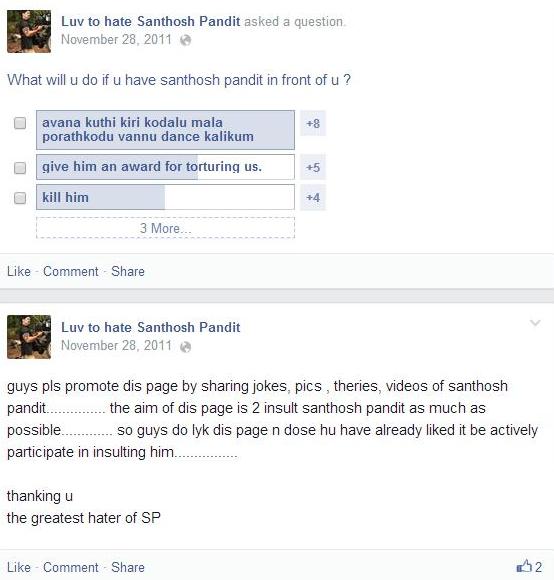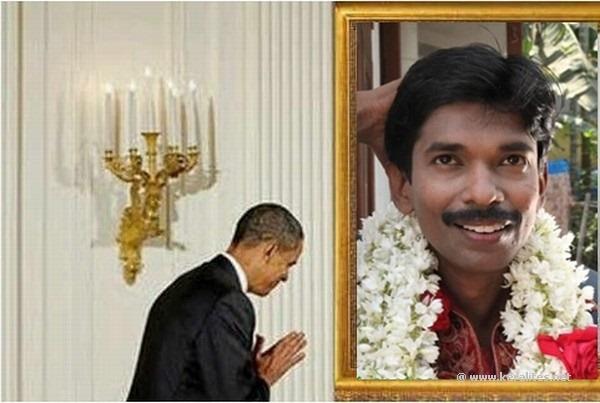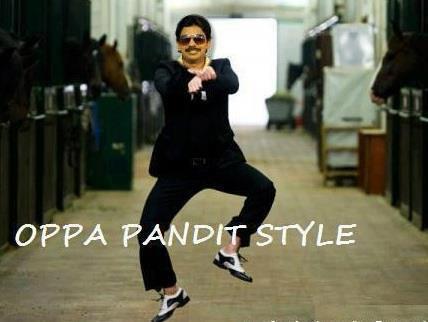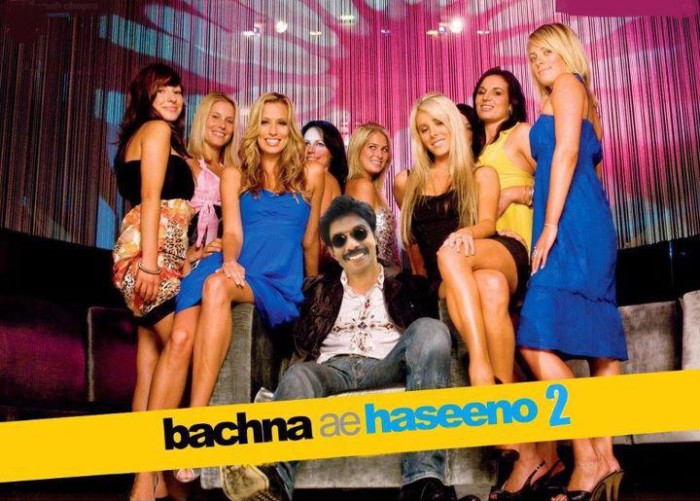This is the third research note from Darshana Sreedhar, one of the short-term social media research fellows at The Sarai Programme.
I. The (Im)material Challenge of Online Ethnography: Walking the Pandit Path
A few days after uploading my last post [1] on Santosh Pandit on the Sarai website, I was flooded with notifications on my academia.edu page, with the search words ranging from “Pandit * researcher”, “woman assistant * Pandit”, “Darshana * Santosh Pandit” among others. My Facebook page was also flooded with friendship requests and messages from complete strangers. Mostly these were in the form of casual queries that were fired by a curiosity to know what my credentials are and whether I am working with Pandit for his new film. While this was one side of the story, there were some others who went overboard by asking if I can share my contact details with them so that they can share with me exclusive and uncensored videos of Pandit’s films. This marked the beginning of several conversations about the shifting terrains of audience identification that Pandit mobilized to market his films and the almost single-handed role of social media in his success.
When I started the online ethnography focusing on the functioning and constitution of Pandit fan/hate groups I received a mixed response. My “material” so to speak included private chats, shared memes, videos, comments, subscription to closed groups, focus group discussions and so on and so forth. Even though I had been using ethnography as a tool for qualitative research, an online ethnography was not an easy task as it was challenging to reach out to the heterogeneous and dispersed set of people whose real identities could never be verified. In quite a contrast to the in-depth conversations and site specificity which might help one unravel the multiple layers of meanings, ruptures and discontinuities in a “field-work” oriented ethnography, an online ethnography had to work through narrow confines of selection in terms of sample size, leaving one with the feeling that there are still strands left unexplored.
If one can use the term “mapping the field” to refer to the spread-out terrain of conversations, the ethnography I have done comprised of online community of Facebook users who were members of groups like “Santosh Pandit Fan’s club” [2], “saNtoSh PanDiT fAnS” [3], “Santosh Pandit” (official page of Santosh Pandit fans) [4], “I hate Santosh Pandit” [5], “Santosh Pandit haters” [6], “We hate Santosh Pandit” [7], “Luv to hate Santosh Pandit” [8], “Santosh Pandit Prithiraj fans padanilam” [9] as source of my enquiry. Some of them had members from both genders, but mostly it was an all-male space. The basic line of distinction that marks online ethnography is the sense of immediacy which it demands from the ethnographer to keep abreast of responses, strategic interventions and counter questions as the interaction unveils in real time. The challenge then is to make use of multi-tasking skills to wade through varied threads of conversations and multiple chat windows to explore the logic behind the memes and photo shopped material used as publicity/hate materials. Since the progress of online ethnography depends also on the access and openness of responses and the time the respondents are willing to share with the ethnographer, in many ways it also pushes the limits of what can otherwise be thought of as things which could be withheld for sake of “privacy” concerns [10].

This, I feel is a drastic shift which also makes online ethnography a participatory space, where the neat division between the ethnographer and the subject of enquiry refuses to hold on and you are expected to be as much open to the queries of your respondents as you are to theirs. The consensus on sharing material came after some of them had done a “background check” on me and information gathered thus becoming leads to subsequent chats (interestingly, the bonding mostly happened over sharing trivia on soft porn films!). By taking recourse to the anonymity of fictitious coinages facilitated by social media, many were quite forthcoming in expressing their discomfort with Pandit, his low-budget formulae, his casting of young girls in films to foreground blossoming sexuality and finally his “strategic” ploy to make the media and hate groups address the publicity on his behalf. But, when asked, most of them revealed that on a one-to-one conversation, they may not have revealed half of what they had said on an online platform. “It is a different ballgame altogether in the real world where one is forced to take up responsibility for what one has said. Here, in the sea of anonymity, one can go ahead and say the most despicable of the things and get away with it,” said Mahesh who uses “Ra-van” as his Facebook name [11].
My access to hate group members was problematic on different levels. For many hate group members of Pandit, a study focusing on Pandit phenomenon reflected the “falling standards of academic seriousness”. Their allegation against an ethnography on Pandit’s filmmaking practices were two-fold. One was that by attempting to unravel the processes which led to the emergence of Pandit, many speculated that my work was degrading the serious academic interest in cinema by promoting what one called “substandard cinema under the guise of popular culture.” If the success of Pandit films were seen as portending the crisis of Malayalam cinema by many film pundits who were quick to see this as a timely warning to the mainstream film makers to take stock of their trade and “mend” their ways, pursuing academic work on Pandit was taking it to a different level. Some others openly challenged me to work with Pandit in one film and see for myself what low-budget form was.
The challenges thrown at the ethnographer in terms of the recalcitrance shown by the respondents in acknowledging the methodology can be a bit hassling. In spite of the initial reluctance to accept the merit of tracking the varied lives of hate groups, my respondents had cooperated to some extent to my insistent queries and clarifications. Many of them shared memes and YouTube links which were circulated over the last two years, adding some even from their personal collection, when I found it difficult to track otherwise. The constant barrage of information and news feed makes it a cumbersome exercise to “fish” out specific material that one looking for. The constantly changing timeline reflects to the information flood, which is reminiscent of an ever increasing and swelling archive which can suck in metadata of all sorts. As I was trying to figure out the circuits through which my association with Santosh Pandit was given a new twist, it was also a realization of how Pandit’s trump card of negative publicity has also implicated my research, clubbing me as one among many Pandit’s women fans who were awaiting chance to work with him.
Rather than an unconditional support, the initial reluctance and skepticism shown by my respondents for online ethnography proved to be an unexpected bonus for me as it helped me narrow down and chart out clearly the purpose of the ethnography. “One can’t trust these media people. Make sure that she is genuine. Let her clearly state what she is looking for,” said Vijay, one of Pandit’s fans, addressing to other members who were also tagged in the reply to my request for interviews. Amidst the twenty plus messages, what struck me as unusual were the messages by members of various Santosh Pandit Hate groups and their improvisation of memes with a signature mark, which translated as an authorial imprint. In the initial phase, I could not make out the differences between the memes made by various groups. But, in one of the focus group discussions, I found members from two different hate groups staking their claim over one particular meme and it were unfinished marks in the photo shopped image which helped them to finally identify the real “author” of the meme.
II. The Ontology of the Meme and the Digital Public: Like, Hate, Share Alike
The word meme has an interesting history as it is derived from two Greek words mimeme, meaning “imitated thing” and mimeisthai, “to imitate.” But, this was given a new connotation by the British evolutionary biologist Richard Dawkins in The Selfish Gene (1976) when he used it to foreground an idea, behavior or style which spreads from person to person within a culture, somewhat analogous to how genes spread in a gene pool. But, with the Internet boom and spread of user generated content through blogs and social media, meme got appropriated to stand for modes of imitation and spoofing [12]. The strand of imitation which Dawkins sees as a vital part of meme also has been part of the multiple strands which added to Pandit’s popularity. In fact, the seething animosity between mimicry artists and Pandit took unexpected trajectories in comedy shows and Pandit paid it back in talk shows when he thanked the mimicry artists who had mimicked and copied him, making him a household name for many [13]. It is the same logic of imitation with a difference that marks the ontology of the Santosh Pandit meme.


In the interaction with members of hate groups, what became evident was that memes served multiple purposes, depending more on the viewer’s prior knowledge of the person/event spoofed.At the same time, no one identified the term “meme” or “meming” (a relatively new term for many of my respondents) in our conversations. On the other hand, they described the act of meming as an extension of their everyday Facebook activity where it featured as what they called padam (picture) with “dialogues”. While there were some memes which were directed at one person in particular, there are also “context memes” which draws liberally from real/contentious events and exposed the contradictory strands which frame the original event. The playful juxtaposition between the “real” and “fictitious” seems to be the underlying logic which structures memes. There were also “ordinary” memes which incorporated visuals from certain films, with appropriate texts to go with it. Like for instance, greetings like “Hello”, “Goodnight”, statements like “miss you” and so on and so forth. Keeping with the tradition of ordinary memes, I was also welcomed to the group with a meme which at one go felt like an offensive remark. By mimicking my association with Pandit through a caricature of a woman holding the clapboard as Pandit looks amused at the actress standing next to him, they were addressing the memes to brim with multiple meanings. Apart from the subtext of compromises and the informal modes of casting, such as a meme also had to do with the extremely sexist framing of women who are ready to work with someone who does not subscribe to the conventional modes of film making. It is in fact true that even Pandit admits that the actresses whom he had cast in his films are students who are school-going and drawn mostly from his fans who are interested to be cast opposite to him. When I voiced my discomfort about the meme, the response was surprisingly, “That’s what we told you earlier that there is a sense of community which we have and what is sexist or not depends on the perception of the viewer. For many of us, it is a part of relating lightly to a situation by cracking a joke or making a meme, which may translate to you as insensitive. Clearly, you are not one among us.” Rather than the ethnographer becoming part of the community, this inability to fit in is what makes an online ethnography a challenging exercise.

The urge to match up with the “real-time” experience of “likes” and “shares” propelled by the social media was such that, prominent Malayalam satellite television channels like Asianet and Surya came up with “live” telecast of programmes, some of which were exclusively on these actresses who had starred in Santosh Pandit’s films. With titles such as Santosh Panditum Nayiakamarum (Santosh Pandit and his actresses) [14], Panditinte Pennungal (The women of Pandit) [15], there were special talk-shows where Pandit and selected actresses of his films appeared before an audience, mostly mimicry artists who were waiting to mock and ridicule the actresses belittling their talent and relegating them as “not-professional-enough.” In many ways, these shows were extending the same template used by the online community when they created an interactive space in the comments section when the song sequences of Krishnanum Radhayum were first uploaded on YouTube. There were even frame-by-frame commentaries of the visuals from the song sequences where the viewers identified the actresses concerned not comfortable with the intimacy shared with Pandit, giving descriptive metaphors to the “groping” and “kissing” which they alleged to have been perpetrated.
This voyeuristic gaze which structured the viewer response was strangely couched as a “moral responsibility” on the part of the self appointed moral guardians to weed off unwarranted tendencies. Relating his discomfort in Pandit’s “use” of school-going girls as actresses, Abhijit, one of the hate group members said, “One always had a feeling that there is much more happening with Pandit and the actresses than what is shown in the romantic song sequences. The comments below the YouTube link became participatory and interactive in a different sense when viewers unabashedly wrote what they perceived to be happening offscreen”[16]. The low budget form of the film and the speculations about the ways his films were shot emerged in the discussion forums. It was in such a context that the rehearsal of shoots of Pandit’s song sequence with actresses found mention among the Youtube links shared widely among many hate group members. For instance, videos titled, “Santosh Pandit film shooting behind the movie” [17] and “Santosh Pandit shooting of film leaked video HOT WITH HEROINE” [18] circulated as “exposed” sequences which made the viewers also privy to the inside stories and casting. But then, there were also fake videos with titles such as “Santosh Pandit sex” [19] and “SEX with SANTHOSH PANDIT – Unseen Video leaked” which made its rounds, giving an impression that there were just copies and the real was somewhere out there. Thus, even the “fake” carried a charge and was in one way announcing the presence of the “real” lurking behind.

The intensity of circulation of these memes was such that even the fan’s groups widely shared memes brought out by the hate groups. “After a point, the memes which were circulated by the hate groups started spoofing the film posters. This was done by replacing the face of certain actors with that of Santosh Pandit. Popularly known as thalavett (cutting of head), the overwhelming presence of Pandit came to be stamped through farfetched associations, which clicked only because of its unbelievability,” said Bhaskar, one of Pandit’s fans. The participatory interface which such interactions provided were such that Pandit phenomenon was mediated through the collaborative exercise of fan/hate groups. “If not for social media, Pandit would have remained one among the many aspirants who wanted to try out all-in-one formula, as someone who could not make much inroads. He owes it to many of us who had utilized our socializing time to chisel out his image,” said one of the hate group members.

In fact, many of my respondents were Malayalis based in Middle East. “After a day’s work, the evenings we spend to connect to family and friends located back home were routed through Facebook and other social media platforms. I never got a chance to watch Pandit’s films in the theatre. But, I don’t think I have missed much because it was on Internet that Pandit made his mark. When I engage in forums through likes and comments, it is also in way participating in the public space of Kerala, which is spatially removed from me,” said Sarabuddin, who works in an oil company in Qatar. He is one among many of my respondents who found the possibilities of a potential public sphere on the Internet. In fact, in many ways the fan/hate groups and online communities perhaps operate as digital publics—one where the virtual space of the Internet allows for a rhizomatic circulation of opinion and discourse with multiple entry points. The simultaneous co-existence of “real” and “fictitious” and the anonymity that this digital public provides however, gives collective participation a different charge. The scattered and anonymous crowd who had watched the song sequences and connected to each through using Pandit’s song sequence got a chance to use theatre as a space to re-view and re-enact the “pokes,” “shares” and “memes” [20]. The heterogeneous pool of Facebook users who engage in the sharing and commenting process also work with a certain notion of time. For instance, Vivek, one of the hate group members said, “The moment you post something, you are looking out for ‘likes,’ ‘shares’ or equally pointed memes. Time is an important factor as delay in drawing comments or likes would mean that it had missed the mark. One tries to deck it with catchy memes and repack it” [21]. More than a polarization based on allegiances, the function of memes is to open the contradictions which structure even the viewing positions and subjectivities of the Facebook users. But, when I pointed to them the misogynistic undertone coloring such memes, one of them said, “It is not offensive and a light entertainment is part and parcel of ‘meming.’ The whole fun is lost if you take it seriously and think of it as politically incorrect. I am sure that Pandit would be more than happy and would promote such memes. The basic reason why meming was so successful with Pandit is because he knows how to take it positively” [22].

The interesting thread which frames the meme is that it is a play which both the parties enter with full knowledge of what it entails. The contested telecast of Malayalee House, which introduced Malayalam television viewers to the “lock down format,” tapping into the “reality” lived by the participants under the perennial eyes of multiple cameras which I will address in the next post is perhaps also a marker of a similar “play.” Like the Pandit phenomenon, the telecast and debates around Malayalee House too mobilized the digital public in similar ways. Hence it is hardly surprising that Pandit himself became part of the show, ending up as one of its most popular contestants. Keeping this in mind, my next post will examine how social media becomes the ideal addressee for the television viewership and how the digital and the televisual public become inextricably enmeshed in the reception of a show like Malayalee House.
Notes
[1] Sreedhar, Darshana. 2014. Santosh Pandit: Negative Publicity and Durablity of the “Superstar of the Poor.” Sarai. Retrieved from http://sarai.net/santosh-pandit-negative-publicity-and-durablity-of-superstar-of-the-poor/.
[2] Retrieved from https://www.facebook.com/SanthoshPanditFansClub.
[3] Retrieved from https://www.facebook.com/groups/453559098018063/.
[4] Retrieved from https://www.facebook.com/pages/Santosh-Pandit/199828910049341.
[5] Retrieved from https://www.facebook.com/ihatesanthoshpandit.
[6] Retrieved from https://www.facebook.com/groups/235129309892020/.
[7] Retrieved from https://www.facebook.com/groups/440615939327825/.
[8] Retrieved from https://www.facebook.com/luv2hate.santosh.pandit.
[9] Retrieved from https://www.facebook.com/pages/Santosh-Pandit/199828910049341.
[10] I am specifically stressing on this because my attempts to create a second Facebook profile for sake of interviews was not taken positively by my respondents who wanted the interviewer also to have “transparency”. “If you are looking for genuine responses, you cannot fake your identity. When we open our timeline to you, you cannot close us out completely from your profile. “At least, that you owe that to us”, said Mahesh on my request to use an alternative Facebook ID for the interviews.
[11] Interview taken with Mahesh taken on August 8, 2014.
[12] This even caught up Dawkins unexpectedly when he became the target of hate mails and memes on account of his atheist beliefs. In one of the memes which circulated virally, his facial similarities with Emma Watson was explored using a morphing software which shows Emma Watson morphs to Richard Dawkins in a GIF format (See: http://www.gifbin.com/984704). This shift in the usage of the term post the Web 2.0 was mobilized by advertisement agency Saatchi and Saatchi when it introduced Dawkins in the ‘New Director’s Showcase 2013’ at the 60th Cannes Lions International festival of creativity (See: http://thecreatorsproject.vice.com/blog/the-saatchi–saatchi-new-directors-showcase-2013-internet-memes-richard-dawkins). The nine minute composition begins with Dawkins introducing how replicability conditioned both genes and memes and how imitation is an integral part of its function. For Dawkins, “Internet meme is a hijacking of the original idea and instead of mutating by random change and spreading a form of Darwinian selectivity, memes are altered deliberately by human creativity” (See: https://www.youtube.com/watch?v=GFn-ixX9edg). In the video, one sees Dawkins withdrawing from the stage after his brief commentary on memes, shifting the scape into an auto-tuned one with psychedelic visuals created by a group of artists, designers and animators (See: http://www.independent.co.uk/life-style/gadgets-and-tech/video-richard-dawkins-attempts-memedom-via-saatchi–saatchi-8674875.html). The lasting image of the meme featured footage of an owl lasering the disembodied head of Dawkins, which in many ways stand as a cross reference to the viral reach of the Frankenstinish nature embedded in the structure of meme, which can travel to unintended trajectories, to the utter despair of the creator, who then gets reduced to a mere spectator.
[13] For instance, Ramesh, one of the mimicry artists who had been invited regularly to talk shows featuring Santoh Pandith says “Like a smart kingpin, he left the dirty job to us as he sat back comfortably, watched the show and basked in the glory of negative publicity”, (Personal Interview, August 15th 2014). Santosh Pandit has himself noted: “I gave you what you need. In the initial phase, I was keen to stress in interviews about how I wanted to have eight actresses, eight songs and eight stunt sequences in my films. The more they spoofed my dress code, including the mismatched coat and glass combination and what they thought to be the exaggerated expression of the self-proclaimed superstar, the more confident I became about my worth” (August 26th, 2014). The Ekalavya Karma Sreshta Award instituted by Ekalavya Charitable Trust which Pandit received in 2011 was given as a moral boost for his daringness to attempt what many feared to tread (See: https://www.youtube.com/watch?v=Yd-Tm8Ex3Xw).
[14] Retrieved from https://www.youtube.com/watch?v=xARztGVEDTE.
[15] Retrieved from https://www.youtube.com/watch?v=bDS8Pw2PCs4.
[16] Interview with Abhijith taken on August 15, 2014.
[17] Retrieved from https://www.youtube.com/watch?v=c3fAzMNNlZk.
[18] Retrieved from https://www.youtube.com/watch?v=RW0DEOhUcg4.
[19] Retrieved from https://www.youtube.com/watch?v=YYWdllrHQ6w.
[20] Retrieved from https://www.youtube.com/watch?v=cxlTCE7K4PY.
[21] Interview with Vivek taken on August 17, 2014.
[22] Interview with Saddy taken on August 5, 2014.
